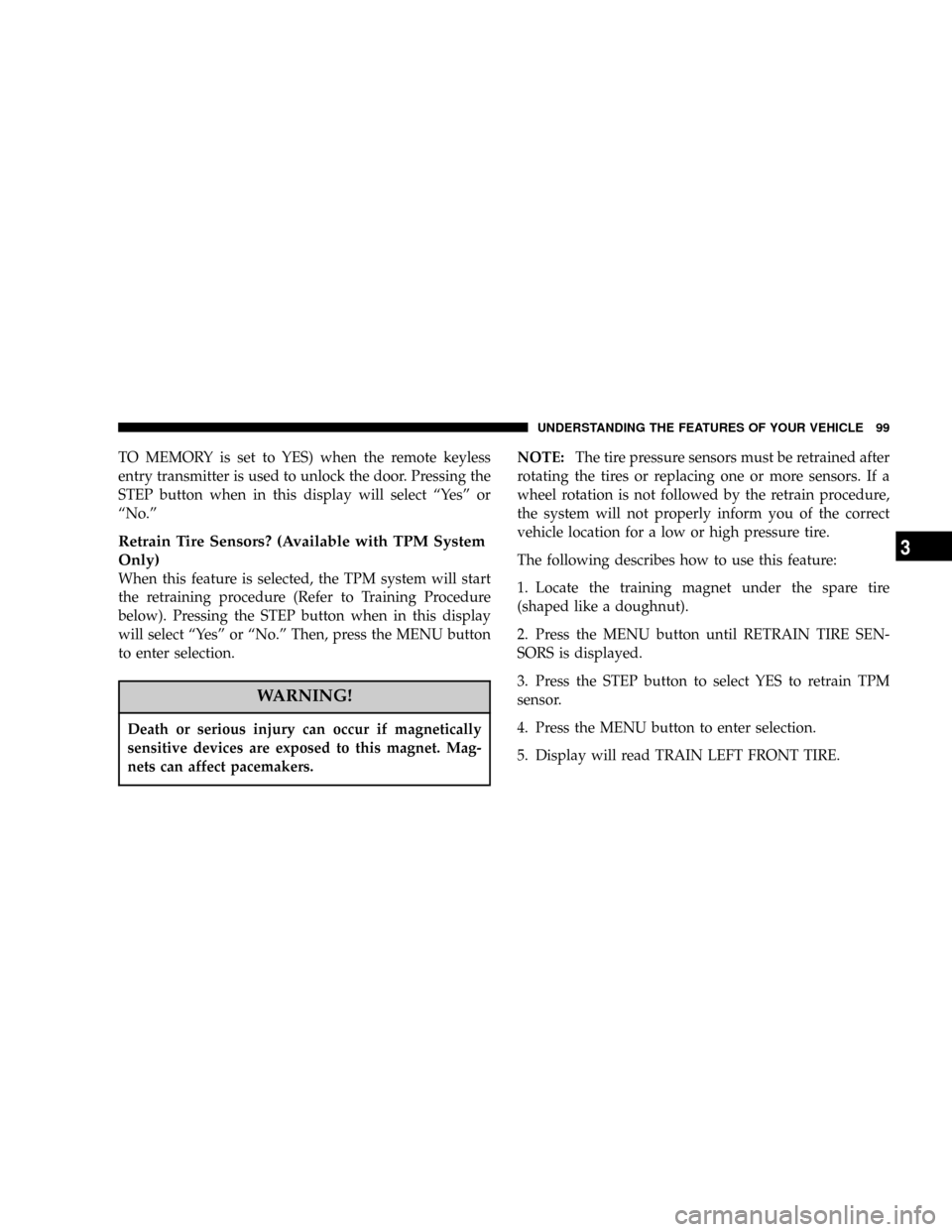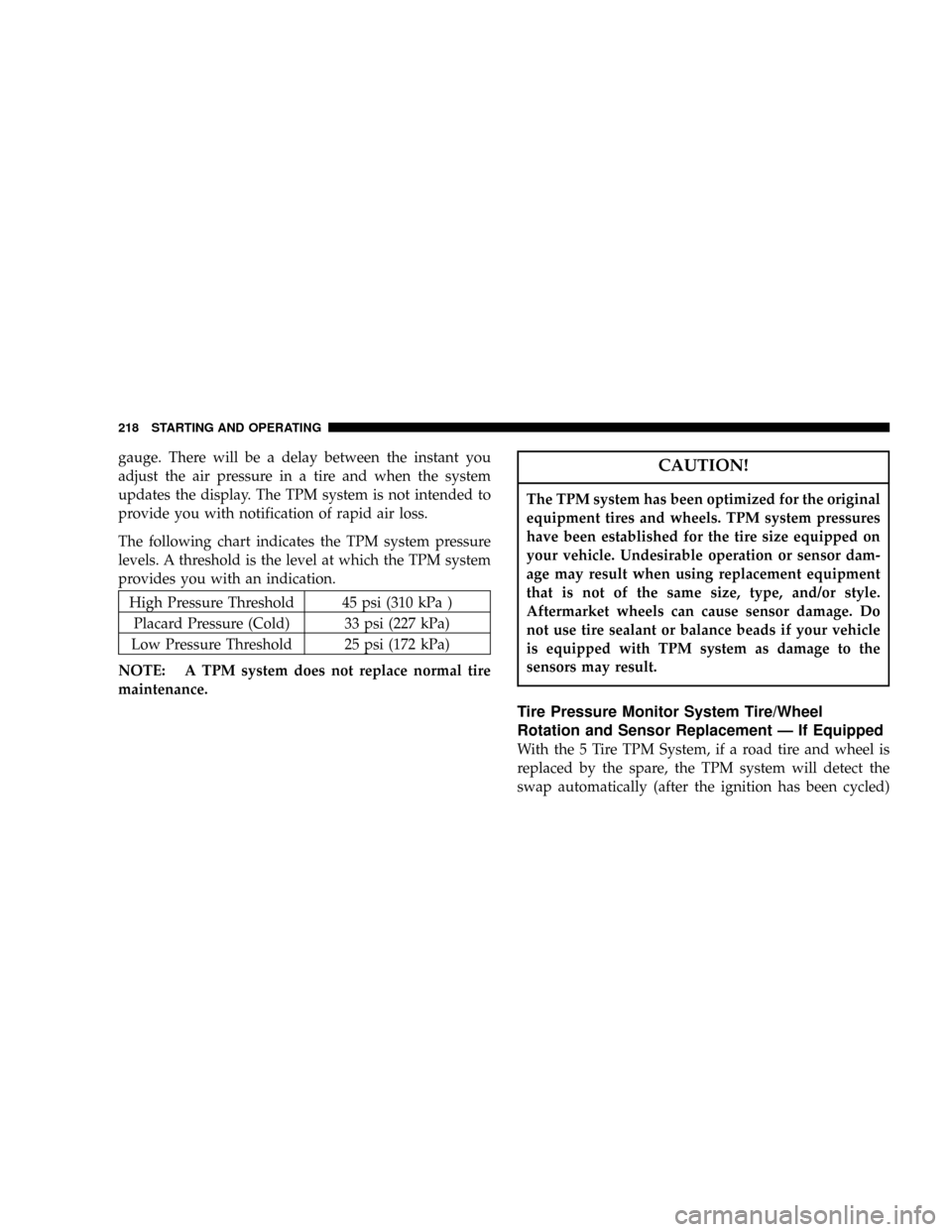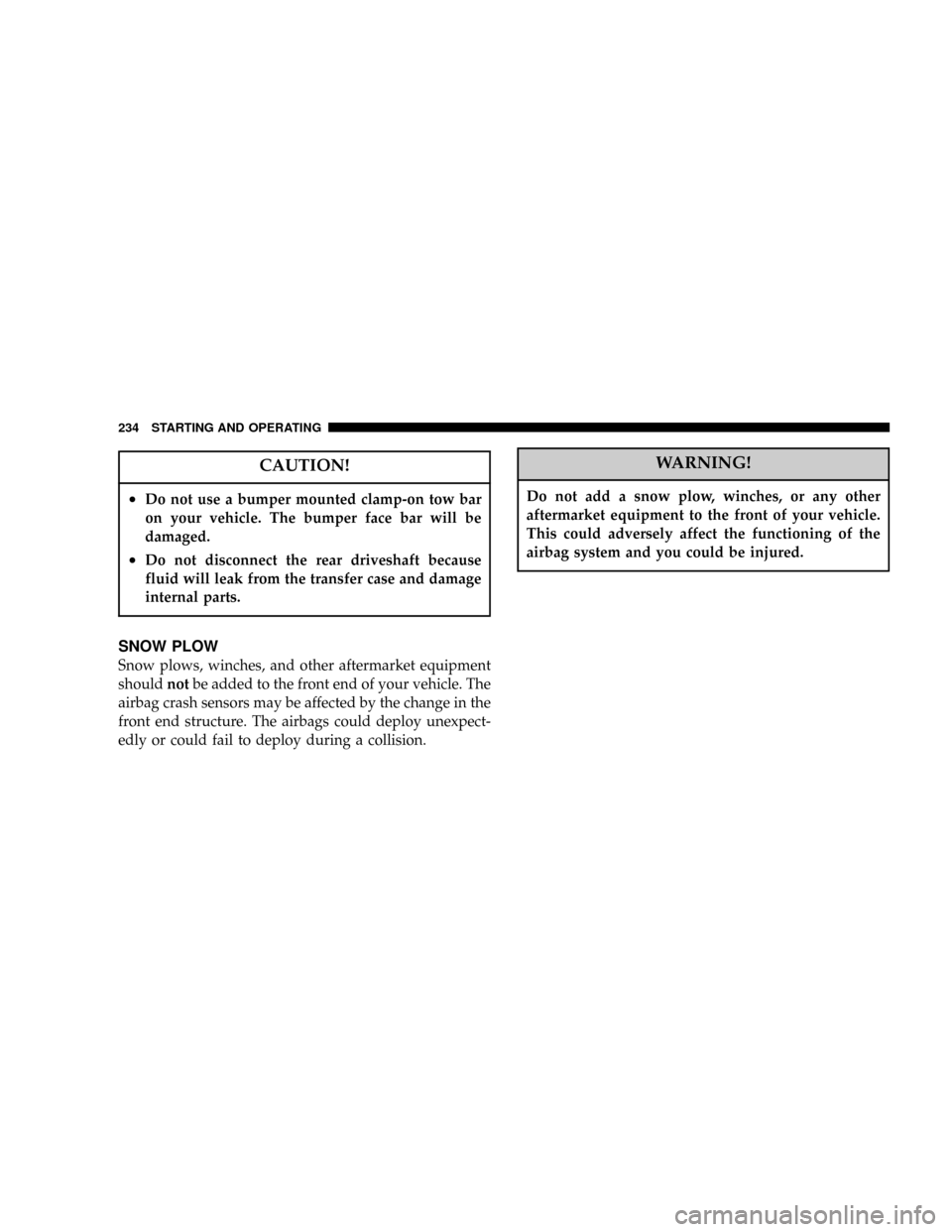sensor JEEP GRAND CHEROKEE 2004 WK / 3.G User Guide
[x] Cancel search | Manufacturer: JEEP, Model Year: 2004, Model line: GRAND CHEROKEE, Model: JEEP GRAND CHEROKEE 2004 WK / 3.GPages: 344, PDF Size: 6.09 MB
Page 99 of 344

TO MEMORY is set to YES) when the remote keyless
entry transmitter is used to unlock the door. Pressing the
STEP button when in this display will select ªYesº or
ªNo.º
Retrain Tire Sensors? (Available with TPM System
Only)
When this feature is selected, the TPM system will start
the retraining procedure (Refer to Training Procedure
below). Pressing the STEP button when in this display
will select ªYesº or ªNo.º Then, press the MENU button
to enter selection.
WARNING!
Death or serious injury can occur if magnetically
sensitive devices are exposed to this magnet. Mag-
nets can affect pacemakers.
NOTE:The tire pressure sensors must be retrained after
rotating the tires or replacing one or more sensors. If a
wheel rotation is not followed by the retrain procedure,
the system will not properly inform you of the correct
vehicle location for a low or high pressure tire.
The following describes how to use this feature:
1. Locate the training magnet under the spare tire
(shaped like a doughnut).
2. Press the MENU button until RETRAIN TIRE SEN-
SORS is displayed.
3. Press the STEP button to select YES to retrain TPM
sensor.
4. Press the MENU button to enter selection.
5. Display will read TRAIN LEFT FRONT TIRE.
UNDERSTANDING THE FEATURES OF YOUR VEHICLE 99
3
Page 100 of 344

NOTE:There is a 60 second timer for training the first
tire and a 30 second timer between training the remain-
ing tires. If either of these timers expire, the EVIC will
abort the training procedure.
6. Starting at the left front tire, place the training magnet
over the valve stem until the horn chirps (This takes
approximately 5 seconds).7. Repeat step 6 working clockwise around the vehicle
(Left Front, Right Front, Right Rear, Left Rear, Spare) until
all five TPM sensor positions are trained.
NOTE:The spare tire is only trained with the 5 Tire
TPM System.
100 UNDERSTANDING THE FEATURES OF YOUR VEHICLE
Page 167 of 344

Defrost/Floor
Air flows through the front and rear floor outlets
and the outlets at the base of the windshield.
Defrost
Air is directed to the windshield through the
outlets at the base of the windshield.
NOTE:To improve fuel economy, leave in defrost only
when necessary.
Infrared Dual-Zone Climate Control Ð If Equipped
The Infrared Dual-Zone Climate Control System auto-
matically maintains the interior comfort level desired by
the driver and passenger. This is accomplished by using
a dual infrared sensor located in the face of the control
unit. The dual infrared sensor independently measures
the surface temperature of the driver and passenger.
Based on the sensor input, the system automatically
adjusts the air flow temperature, the air flow volume, andamount of outside air recirculation. This maintains a
comfortable temperature even under changing condi-
tions.
Operation of the system is quite simple. Begin by turning
the right mode knob to AUTO. Dial in the temperature
you would like the system to maintain by rotating the
driver's or passenger's control knob. Once the comfort
UNDERSTANDING YOUR INSTRUMENT PANEL 167
4
Page 175 of 344

NTire Spinning........................214
NTread Wear Indicators..................215
NReplacement Tires.....................215
NAlignment And Balance.................217
mTire Pressure Monitor System Ð If Equipped . . . 217
NTire Pressure Monitor System Tire/Wheel
Rotation And Sensor Replacement Ð If
Equipped...........................218
NGeneral Information...................219
mTire Chains...........................220
mTire Rotation Recommendations............220
mFuel Requirements......................221
NReformulated Gasoline.................222
NGasoline/Oxygenate Blends..............222NMMT In Gasoline.....................223
NSulfur In Gasoline.....................223
NMaterials Added To Fuel................224
mFuel Tank Filler Cap (Gas Cap).............224
mTrailer Towing.........................226
NTrailer And Tongue Weight..............228
NCooling System TipsÐTrailer Towing.......229
NMinimum Vehicle Requirements For Trailer
Towing............................230
mRecreational Towing (Behind Motorhome, Etc.) . . 231
NShifting Into Neutral (N)................232
NShifting Out Of Neutral (N)..............233
mSnow Plow...........................234
STARTING AND OPERATING 175
5
Page 217 of 344

Alignment and Balance
The suspension components of your vehicle should be
inspected and aligned when needed, to obtain maximum
tire tread life.
Poor suspension alignment may result in:
²reduced tread life;
²uneven tire wear, such as feathering and one-sided
wear;
²vehicle pull to the right or to the left.
Tires may also cause the vehicle to pull left or right.
Alignment will not correct this problem. See your dealer
for proper diagnosis of the problem.
Improper alignment will not normally cause vehicle
vibration, which may be a result of tire and wheel
out-of-balance. Proper balancing will reduce vibration
and avoid tire cupping and spotty wear.
TIRE PRESSURE MONITOR SYSTEM Ð IF
EQUIPPED
The Tire Pressure Monitor System (TPM) monitors the
pressure in all 4 road tires and the full size spare (5 Tire
TPM System Only). The TPM system uses wireless
technology to monitor tire pressure levels. Sensors,
mounted to each wheel as part of the valve stem, transmit
tire pressure readings to a receiver located in the over-
head console. The tire pressure status is shown in the
Electronic Vehicle Information Center (EVIC) display.
Refer to ªOverhead Consoleº in Section 3 for more
information. The TPM system functions even when the
EVIC is not set on the tire pressure display screen.
The TPM system informs you of a low or high tire
pressure condition. If this occurs, correct your tire infla-
tion pressure as soon as possible, and inspect all of your
tires. Be sure to use a high quality gauge when adjusting
pressure. The TPM system is designed to monitor your
tire pressure but will not function as a tire pressure
STARTING AND OPERATING 217
5
Page 218 of 344

gauge. There will be a delay between the instant you
adjust the air pressure in a tire and when the system
updates the display. The TPM system is not intended to
provide you with notification of rapid air loss.
The following chart indicates the TPM system pressure
levels. A threshold is the level at which the TPM system
provides you with an indication.
High Pressure Threshold 45 psi (310 kPa )
Placard Pressure (Cold) 33 psi (227 kPa)
Low Pressure Threshold 25 psi (172 kPa)
NOTE: A TPM system does not replace normal tire
maintenance.
CAUTION!
The TPM system has been optimized for the original
equipment tires and wheels. TPM system pressures
have been established for the tire size equipped on
your vehicle. Undesirable operation or sensor dam-
age may result when using replacement equipment
that is not of the same size, type, and/or style.
Aftermarket wheels can cause sensor damage. Do
not use tire sealant or balance beads if your vehicle
is equipped with TPM system as damage to the
sensors may result.
Tire Pressure Monitor System Tire/Wheel
Rotation and Sensor Replacement Ð If Equipped
With the 5 Tire TPM System, if a road tire and wheel is
replaced by the spare, the TPM system will detect the
swap automatically (after the ignition has been cycled)
218 STARTING AND OPERATING
Page 219 of 344

and display SPARE SWAP DETECTED along with a
chime. This could take up to 10 minutes with vehicle
speed above 25 mph (40 km/h).
With the 4 Tire TPM System, if a road tire and wheel is
replaced by the spare, the TPM system will display TIRE
SENSOR BAD/MISSING. This is due to the spare tire not
being equipped with a tire pressure sensor. Once the road
tire is repaired and/or installed back on the vehicle with
the proper tire pressure the message will be removed.
This could take up to 10 minutes with vehicle speed
above 25 mph (40 km/h).
The tire pressure sensorsmustbe retrained following a
wheel rotation or sensor replacement. Refer to ªEVIC Ð
Retrain Tire Sensorsº in Section 3 for more information. It
is necessary to program the EVIC with the new sensor(s)
or the new position of each sensor as it is rotated to a
different corner of the vehicle.If a wheel rotation is not followed by the retrain proce-
dure, the system will not properly inform you of the
correct vehicle location of a low or high tire pressure.
General Information
This device complies with part 15 of the FCC rules and
RSS 210 of Industry Canada. Operation is subject to the
following conditions:
²This device may not cause harmful interference.
²This device must accept any interference received,
including interference that may cause undesired op-
eration.
The tire pressure sensors are covered under one of the
following licenses:
United States.....................KR5S120123
Canada........................2671-S120123
STARTING AND OPERATING 219
5
Page 234 of 344

CAUTION!
²Do not use a bumper mounted clamp-on tow bar
on your vehicle. The bumper face bar will be
damaged.
²Do not disconnect the rear driveshaft because
fluid will leak from the transfer case and damage
internal parts.
SNOW PLOW
Snow plows, winches, and other aftermarket equipment
shouldnotbe added to the front end of your vehicle. The
airbag crash sensors may be affected by the change in the
front end structure. The airbags could deploy unexpect-
edly or could fail to deploy during a collision.
WARNING!
Do not add a snow plow, winches, or any other
aftermarket equipment to the front of your vehicle.
This could adversely affect the functioning of the
airbag system and you could be injured.
234 STARTING AND OPERATING
Page 268 of 344

attention should also be given to hood latching compo-
nents to insure proper function. When performing other
underhood services, the hood latch, release mechanism
and safety catch should be cleaned and lubricated.
The external lock cylinders should be lubricated twice a
year, preferably in the fall and spring. Apply a small
amount of a high quality lubricant such as MopartLock
Cylinder Lubricant directly into the lock cylinder.
Windshield Wiper Blades
The rubber edges of the wiper blades and the windshield
should be cleaned periodically with a sponge or soft cloth
and a mild nonabrasive cleaner to remove accumulations
of salt or road film.
Operation of the wipers on dry glass for long periods
may cause deterioration of the wiper blades. Always use
washer fluid when using the wipers to remove salt or dirt
from a dry windshield.Avoid using the wiper blades to wipe frost or ice from the
windshield. Keep the blade rubber out of contact with
petroleum products such as engine oil, gasoline, etc.
Windshield Washers Ð Front and Rear
On vehicles equipped with a Vehicle Information Center,
the low washer fluid level will be indicated. When the
sensor detects a low fluid level, the windshield will light
on the vehicle graphic outline and the ªWasher Fluid
Lowº message will be displayed.
The fluid reservoir for the windshield washers and the
rear window washer is shared. It is located in the front of
the engine compartment on the passenger side and
should be checked for fluid level at regular intervals. Fill
the reservoir with windshield washer solvent (not radia-
tor antifreeze) and operate the system for a few seconds
to flush out the residual water.
268 MAINTAINING YOUR VEHICLE